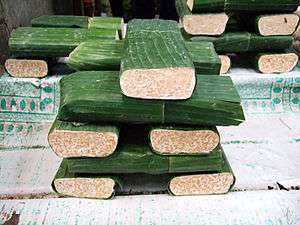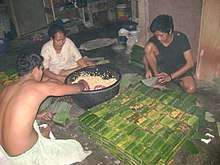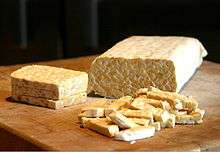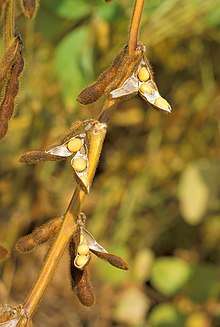Tempeh
Tempeh or tempe (/ˈtɛmpeɪ/; Javanese: témpé, Javanese pronunciation: [tempe]) is a traditional Indonesian soy product, that is made from fermented soybeans.[1] It is made by a natural culturing and controlled fermentation process that binds soybeans into a cake form.[2] Here a special fungus is used, which has the Latin name Rhizopus oligosporus, usually marketed under the name tempeh starter.
_3.jpg)
 Fresh tempeh at the market, Jakarta, Indonesia – traditionally, tempeh is wrapped in banana leaves. | |
| Alternative names | Tempe |
|---|---|
| Place of origin | Indonesia[1] |
| Region or state | Central Java, East Java, Special Region of Yogyakarta |
| Main ingredients | Soybeans |
It is especially popular on the island of Java, where it is a staple source of protein. Like tofu, tempeh is made from soybeans, but it is a whole soybean product with different nutritional characteristics and textural qualities. Tempeh's fermentation process and its retention of the whole bean give it a higher content of protein, dietary fiber, and vitamins. It has a firm texture and an earthy flavor, which becomes more pronounced as it ages.[3][4]
Etymology
The etymology of the term tempe itself is suggested to be derived from Old Javanese tumpi, a whitish food made from fried batter made from sago or rice flour which resembles rempeyek.[5] Historian Denys Lombard suggests however that it is linked to the local term tape or tapai which means "fermentation".[6]
History

Tempeh originated in Indonesia, almost certainly in Java, more precisely central or east Java,[1] with an estimated discovery between a few centuries ago to a thousand years or more.[7]:145 Around the 12th to 13th century, a type of food was mentioned as kadêlê in an old Javanese manuscript, Serat Sri Tanjung.[6] However, it is not clear whether kadêlê refers to processed fermented soy or not, since the term in Javanese today refers to "soybeans". The earliest known reference to it as têmpê appeared in 1815 in the Serat Centhini.[6]
The invention of tempeh is connected to tofu production in Java. The tofu-making industry was introduced to Java by Chinese immigrants circa the 17th century. Chinese Indonesian historian Ong Hok Ham suggests that tempeh was accidentally produced as the by-product of the tofu industry in Java; as discarded soybeans caught the spores of a whitish fungus that was found to be edible.[6] Three detailed, fully documented histories of tempeh, worldwide, have been written, all by Shurtleff and Aoyagi (1985, 1989, and 2001).
Production

Tempeh begins with whole soybeans, which are softened by soaking, and dehulled, then partly cooked. Specialty tempeh may be made from other types of beans, wheat, or may include a mixture of beans and whole grains.
The principal step in making tempeh is the fermentation of soybeans which undergo inoculation with Rhizopus spp. molds, a type of filamentous fungus most widely used for the production of tempeh.[8] A fermentation starter containing the spores of fungus Rhizopus oligosporus or Rhizopus oryzae is mixed in.[9] The beans are spread into a thin layer and are allowed to ferment for 24 to 36 hours at a temperature around 30°C (86°F). The soybeans have to cool down to allow spore germination and abundant growth of mycelium. Later, the temperature of the beans will naturally rise and rapid mold growth happens for around 4 hours. As mold growth declines, the soybeans should be bound into a solid mass by the mycelium. In good tempeh, the beans are knitted together by a mat of white mycelium. Typically, tempeh is harvested after 48 hours of fermentation with its distinguishable whitish color, firm texture, and nutty flavor. Extended fermentation time results in an increase in pH and undesirable color darkening in the tempeh.[10]
During the fermentation process, optimal time of fermentation, temperature, oxygen, humidity, and pH levels are required to encourage the growth of the Rhizopus mold, while discouraging the growth of undesired microorganisms.[11] The pH level should be kept around 3-5 by adding a mild acidulant such as vinegar, lactic acid, or acetic acid, thereby favoring mold growth and restricting the growth of spoilage microorganisms.[12] Oxygen is required for Rhizopus spp. growth, but should be maintained at low levels to prevent the production of undesired microorganisms. Under conditions of lower temperature, or higher ventilation, gray or black patches of spores may form on the surface—this is not harmful, and should not affect the flavor or quality of the tempeh.[13] This sporulation is normal on fully mature tempeh. A mild ammonia smell may accompany good tempeh as it ferments, but it should not be overpowering.
Traditional tempeh is often produced in Indonesia using Hibiscus tiliaceus leaves. The undersides of the leaves are covered in downy hairs (known technically as trichomes) to which the mold Rhizopus oligosporus can be found adhering in the wild. Soybeans are pressed into the leaf, and stored. Fermentation occurs resulting in tempeh.[14] In particular, the tempeh undergoes salt-free aerobic fermentation.[15]
Determining quality
Once tempeh is produced, it is divided into three categories based on its quality: good, unfinished, and inedible. Good tempeh includes beans that are bound into a firm, compact cake by a dense, uniform, white mycelium, which should permeate the entire cake; the beans should be barely visible. The odor of good tempeh should be pleasant, clean, subtly sweet or resemble the aroma of mushrooms. The entire tempeh should lift as a single, cohesive cake without crumbling when shaken gently. Unfinished tempeh has beans that are bound together loosely by a sparse white mycelium, hence it crumbles easily. Unfinished tempeh should be incubated longer unless it has been incubated more than 8 hours past the recommended time. If it has been incubated for enough time and still remains unfinished, it should be discarded. Inedible tempeh has beans with foul odor, resembling strong ammonia or alcohol, indicating the development of undesirable bacteria due to excess moisture or overheating. Inedible tempeh cake is wet, slimy, and mushy with a collapsed structure. Its color is tan to brown and mold develops in sparse patches.[12]
Packaging

Food grade wrapping paper and perforated polyethylene bags are the most suitable materials for packaging tempeh. They have demonstrated good retention of the quality of tempeh and extension of the shelf life of tempeh for three days compared to fresh tempeh. Appropriate packaging is important as it provides optimum oxygen supply and temperature for inoculation and fermentation to occur during processing.[16] Tempeh is a perishable food and must be wrapped and placed into the refrigerator or freezer immediately after incubation or other processing steps such as blanching. In the refrigerator or freezer, stacking of tempeh should be minimized to prevent overheating and the undesirable, gradual continuation of fermentation, both of which shorten the storage life of tempeh. Even under cold temperature, tempeh continues to respire and undergo slow decomposition from microorganisms and its natural enzymes. Therefore, tempeh should be well cooled for at least two to five hours in a cooler before they undergo further packaging.[12] Tempeh packaged in perforated polyethylene bags is usually repacked inside another labeled, non-perforated bag for distribution and sale, and for easier labeling. If the tempeh is only packaged in one perforated bag, the label must be directly attached to the perforated surface with the use of government food contact approved adhesive.[16] They are then bulk packed in cartons and returned to the refrigerator or freezer to await shipment.[12]
Nutrition
| Nutritional value per 100 g (3.5 oz) | |
|---|---|
| Energy | 803 kJ (192 kcal) |
7.64 g | |
10.80 g | |
20.29 g | |
| Vitamins | Quantity %DV† |
| Thiamine (B1) | 7% 0.078 mg |
| Riboflavin (B2) | 30% 0.358 mg |
| Niacin (B3) | 18% 2.640 mg |
| Vitamin B6 | 17% 0.215 mg |
| Folate (B9) | 6% 24 μg |
| Vitamin B12 | 3% 0.08 μg |
| Minerals | Quantity %DV† |
| Calcium | 11% 111 mg |
| Iron | 21% 2.7 mg |
| Magnesium | 23% 81 mg |
| Manganese | 62% 1.3 mg |
| Phosphorus | 38% 266 mg |
| Potassium | 9% 412 mg |
| Sodium | 1% 9 mg |
| Zinc | 12% 1.14 mg |
| Other constituents | Quantity |
| Water | 59.65 g |
| |
| †Percentages are roughly approximated using US recommendations for adults. Source: USDA Nutrient Database | |
The soy carbohydrates in tempeh become more digestible as a result of the fermentation process. In particular, the oligosaccharides associated with gas and indigestion are greatly reduced by the Rhizopus culture. In traditional tempeh-making shops, the starter culture often contains beneficial bacteria that produce vitamins such as B12[17][18] (though it is uncertain whether this B12 is always present and bioavailable).[19] In western countries, it is more common to use a pure culture containing only Rhizopus oligosporus, which makes very little B12 and could be missing Citrobacter freundii and Klebsiella pneumoniae, which have been shown to produce significant levels of B12 analogs in tempeh when present.[20] Whether these analogs are true, bioavailable B12 has not been thoroughly studied yet.[21] The fermentation process also reduces the phytic acid in soy,[22] which in turn allows the body to absorb the minerals that soy provides.
Preparation
In the kitchen, tempeh is often simply prepared by cutting it into pieces, soaking in brine or salty sauce, and then fried. In Java, tempeh is often traditionally prepared by cutting it into pieces, marinated in a mixture of ground garlic, coriander and turmeric, salt and water; then deep fried,[23] and often served with sambal ulek chili paste. Cooked tempeh can be eaten alone, or used in chili, stir fries, soups, salads, sandwiches, and stews. Tempeh's complex flavor has been described as nutty, meaty, and mushroom-like. It freezes well, and is now commonly available in many western supermarkets, as well as in ethnic markets and health food stores. Tempeh can be steamed, marinated, thinly sliced, blackened, or crumbled into sauces and stews.[24]
Tempeh performs well in a cheese grater, after which it may be used in the place of ground beef (as in tacos). When thin-sliced and deep-fried in oil, tempeh obtains a crisp golden crust while maintaining a soft interior. Its sponge-like consistency makes it suitable for marinating. Dried tempeh (whether cooked or raw) is more portable and less perishable and may be used as a stew base. Sometimes when tempeh is diced and left, they will create white feathery fluff which bonds the cut—this is the Rhizopus mold still growing—this is normal and perfectly edible.
Types

The most common tempeh is made from fermented soybeans. However, traditionally other ingredients such as ampas tahu (tofu dregs/okara), ampas kelapa (coconut dregs) and peanuts may be used in a fashion similar to the tempeh making process, although perhaps using different fungi or attracting other microbes.
Tempeh kedelai
Also called tempeh kedele or tempeh dele, or simply just tempeh. The most common and widely known tempeh, made from controlled fermentation of soybeans.
Tempeh gembus
Soft and fluffy tempeh made from soy pulp or tofu dregs.[25][26] Tempeh gembus usually can be found in traditional markets of Java, at a price lower than that of common soybean tempeh. It is made into a variety of dishes; for example it can be battered and/or fried, used in sayur lodeh, or tempeh bacem. Tempeh gembus is known by different names across Java; for example as tahu cokol or tahu susur in Temanggung.[25]
Oncom
Tempeh oncom, or simply onchom, is made from peanut press cake or soy dregs. Among fermented bean products, oncom is more prevalent in West Java, where it serves as the main ingredient in various Sundanese cuisine traditional dishes, including oncom goreng, oncom leunca, and nasi tutug oncom. There are two types of oncom: a bright red-orange kind with Neurospora sitophila, and a black one with the same fungi as tempeh uses.[27]
Tempeh menjes kacang
A specialty of Malang, the rough textured tempeh menjes kacang is made from black soybeans mixed with other ingredients, such as peanut dregs, cassava fiber, and soybean meal. The process of making menjes kacang is quite similar to black oncom.[28]
Tempe bongkrèk
Tempeh bongkrèk is a variety of tempeh from Central Java, notably Banyumas regency, that is prepared with coconut dregs. This type of tempeh has led to several cases of fatal food poisoning,[29] as it occasionally gets contaminated with the bacterium Burkholderia gladioli, and the unwanted organism produces toxins (bongkrek acid and toxoflavin) from the coconut, besides killing off the Rhizopus fungus due to the antibiotic activity of bongkrek acid.[26]
Fatalities from contaminated tempeh bongkrèk were once common in the area where it was produced.[30] Thus, its sale is now prohibited by law; clandestine manufacture continues, however, due to the popular flavor. The problem of contamination is not encountered with bean and grain tempeh, which have a different composition of fatty acids that is not favorable for the growth of B. gladioli, but encourages growth of Rhizopus instead. When bean or grain tempeh has the proper color, texture and smell, it is a very strong indication the product is safe. Yellow tempeh bongkrèk is always highly toxic due to toxoflavin, but tempeh bongkrèk with a normal coloration may still contain lethal amounts of bongkrek acid.[31]
Process
Sometimes tempeh is left to ferment further, creating a pungently stronger "almost rotten" tempeh called tempeh semangit in Javanese.[33]
The wrappings used in tempeh making can contribute to its flavor and aroma. Though some prefer the traditional banana, waru or teak leaf, readily available plastic sheet wrappings have been increasingly widely used.
Common tempeh
Common soybean tempeh that has undergone sufficient fermentation process.
Tempeh semangit
In Indonesia, ripe tempeh (two or more days old) is considered a delicacy. Names include tempeh semangit ("stinky tempeh") in Java, hampir busuk ("almost rotten") tempeh or tempeh kemarin ("yesterday tempeh"). Having a slightly pungent aroma, small amounts are used as a flavoring agent in traditional Javanese sayur lodeh vegetable stew and nasi tumpang.[33]
Tempeh gódhóng
In Javanese language, the term gódhóng means "leaf".[34] Traditionally tempeh is wrapped in organic banana leaf, daun waru (Hibiscus tiliaceus leaf) or daun jati (teak leaf).[35]
Tempeh murni
Pure soybean cake, tempeh made in plastic wrap without any fillings or additives such as grated raw papaya. This was meant to create a more "hygienic and pure" tempeh free from any impurities or unwanted microbes.
Cooking methods and recipes

The simplest way to cook tempeh is by frying. It is both deep-fried and stir-fried. However, there are several cooking methods and recipe variations. Among others are:
Tempeh goreng
Probably the simplest and most popular way to prepare tempeh in Indonesia. The tempeh is sliced and seasoned in a mixture of ground garlic, coriander seeds and salt, and then deep fried in palm oil.[36] The tempe might be coated in batter prior to frying, or directly fried without any batter.
Tempeh bacem
Tempeh bacem is a traditional Javanese dish originating in Central Java. Bacem is a Javanese cooking method of braising in spices and palm sugar. The tempeh is first braised in a mixture of coconut water, palm sugar, and spices including coriander seeds, shallots, galangal, and bay leaves, and then briefly deep-fried. The result is a moist, sweet and spicy, dark-colored tempeh. Tofu may also be used, yielding tahu bacem.[37]
Tempeh mendoan

This variation is often found in Purwokerto. The word mendoan originates in the Banyumas regional dialect, and means "flash-fried". The tempeh is first dipped in spiced flour before quickly frying in very hot oil, resulting in a product that is cooked on the outside, but raw or only partially so on the inside. It has a limp, soft texture compared to the more common, crisp, fully fried tempeh.
| Wikibooks Cookbook has a recipe/module on |
Tempeh kering
Also known as kering tempeh (lit: "dry tempeh"), or sambal goreng tempeh if mixed with plenty of hot and spicy sambal chili pepper sauce. It is a crispy, sweet and spicy, fried tempeh.[38] The raw tempeh is cut into small sticks and thoroughly deep-fried until no longer moist, and then mixed with palm sugar, chili pepper or other spices, or with sweet soy sauce. Often it is mixed with separately fried peanuts and anchovies (ikan teri). This dry tempeh will keep for up to a month if cooked and stored properly.
Tempeh orek or orak-arik tempeh
This variation is almost identical to tempeh kering, but is more soft and moist.[39] The sweet taste is due to generous addition of kecap manis (sweet soy sauce).[40]
Tumis tempeh or oseng tempeh
Stir-fried tempeh with vegetables such as green bean, basil, or onion, with spices.[41] Other recipes might add coconut milk for a milky-colored, and rather moist, stir-fried tempeh.
Tempeh penyet
Fried tempeh mixed with sambal chili paste in a mortar and pestle. Usually served in addition to other penyet dishes, such as ayam penyet (chicken) or iga penyet (ribs).
Tempeh satay
Tempeh skewered and grilled as satay.
Sate kere (Javanese for "poorman's satay") from Solo in Central Java is made from fluffy tempeh gembus.[42] Ground tempeh can also be made into a thick sauce, such as in sate ambal, a chicken satay from Kebumen, Central Java where tempeh flavored with chili and spices replaces the more common peanut sauce.[43]
Kripik tempeh
Kripik tempeh snack crackers; a thinly sliced tempeh, battered and deep fried until crispy. It is popular across Java, but notably produced in Bandung, West Java.
Grilled tempeh
Grilled tempeh over charcoal or fire.[44]
Tempeh sandwich or tempeh burger
Fried, grilled or otherwise cooked tempeh patties, sandwiched between slices of bread or hamburger buns with salad, sauces or seasonings.[45]
- Tempeh dishes
- The common tempeh goreng (un-battered) in Indonesia
 Fried tempeh (battered) sold at a food court in Singapore
Fried tempeh (battered) sold at a food court in Singapore- Tempeh bacem
 Tempeh mendoan
Tempeh mendoan- Kering tempeh or sambal goreng tempeh
- Tempeh orek or orak-arik tempeh
- Tempeh penyet
- Crispy kripik tempeh as a snack
- Fried menjes kacang
.jpg) Grilled tempeh
Grilled tempeh Tempeh sandwich
Tempeh sandwich
Preservation
Freshly made, raw tempeh remains edible for a few days at room temperature. It is neither acidic nor does it contain significant amounts of alcohol. It, however, does possess stronger resistance to lipid peroxidation than unfermented soybeans due to its antioxidant contents.[46]
Cooked as tempeh kering, the deep fried and seasoned bits of tempeh can last for a month or more and still be good to consume, if cooked correctly and stored properly in air-tight jar. The deep frying process removes the moisture, preventing further fermentation and deterioration, thus prolonging its shelf life.
Antimicrobial agents
Rhizopus oligosporus culture responsible for the fermentation of tempeh from soybean produces natural, heat stable antimicrobial agents against spoilage and disease-causing microorganisms, extending the shelf life of the fermented product through microbial antagonism. The mold is capable of inhibiting the growth of other fungi such as Aspergiluus flavus and Aspergillus parasiticus by interfering with the accumulation of aflatoxin (especially aflatoxin B1), the mycotoxin of greatest concern. R. oligosporus has also been reported to produce four to five antibacterial substances during fermentation process. It produces phenolic compounds against pathogenic bacteria such as Helicobacter pylori and an antibacterial protein has been identified with activities against Bacillus species (especially against Bacillus subtilis), Staphylococcus aureus, and Steptococcus cremoris.[8]
Non-refrigerated fresh tempeh
Tempeh can be sold and consumed fresh within 48 hours once removed from its incubator. It is commonly transported to the market in its incubation container (e.g. polyethylene bag, banana leaf wrapper, etc.) and placed in the shade. In areas with warmer climates, tempeh can be kept at room temperature for 1–3 days before it becomes overripe. In locations with more temperate temperatures, it can keep for 1–4 days but will usually need to be refrigerated to prevent spoilage.[12]
Refrigeration
Fresh refrigerated tempeh should be sealed in a labeled polyethylene bag and kept in temperatures below 4 °C (40 °F). It can be kept at this temperature for 3–5 days and sometimes, even as long as a week. Storage life could be extended to 2 or 3 weeks if the tempeh is blanched or steamed prior to refrigeration due to the inactivation of enzymes and destruction of bacteria.[12]
Freezing
Freezing is the preferred way to preserve tempeh due to its capability for wide distribution. Tempeh can be frozen whole or in slices, depending on preference. During the freezing process, whole tempeh is placed in its perforated wrapper whereas sliced tempeh is packaged in a labelled polyethylene bag prior to being sealed in an outer bag and then frozen immediately. This method will keep for months with only a small loss of texture and flavor.[12]
Blanching
Blanching tempeh by steaming or parboiling helps to extend the storage life by preventing bacterial growth, stopping mold growth and inactivating enzymes. Steaming appears to have a less negative effect than parboiling in terms of texture, flavor and nutritional value. Blanching is a great method for preserving tempeh prior to refrigeration, though not as beneficial for tempeh that is to be frozen.[12]
Dehydration
Air tray drying
Tempeh can be dried via the air tray drying method. Cubes of tempeh placed on steel, mesh bottom trays are dried by the circulating hot air dryer. After the product is finished, they can be cut into 2.5-centimetre (1-inch) squares at 90 °C (200 °F) for 90 to 120 minutes in order to reduce moisture content to 2-4%. When placed in moisture proof Pliofilm bags, the tempeh has a shelf life of several months at room temperature. Although this is a convenient method that produces a shelf stable product without requirement of refrigeration, the process of hot air drying can cause a significant loss of nutritional content such as the soluble solids and nitrogen protein content.[12]
Sun drying
This preservation method is most economical out of all methods. The tempeh can be blanched prior to dehydration to preserve flavor and prolong shelf life. Tempeh is exposed to internal solar dryer temperature of 80–90 °C (180–200 °F) in this method. A disadvantage of this method is that sunlight can destroy some of the vitamin B12 of tempeh.[12]
Freeze drying
This method is the most expensive out of all dehydration methods but provides the advantage of long stable shelf life at room temperature and an excellent retention of soluble nutrients (nitrogen protein and other solids). The product undergoes quick freeze at 10 °C (50 °F) and then dried at a moderate temperature inside a strong vacuum. Due to the pricey nature of the equipment, the final product price will be higher than tempeh preserved through other methods.[12]
Spray drying
As this method is traditionally used for small particles, it is used to produce tempeh powder for products such as soups, breads, tortillas, etc. However, this method can be expensive due to the bulky nature of the equipment.[12]
Deep frying
This method produces ready to eat tempeh products. A culinary oil with a high smoke point, such as rapeseed, soy, safflower, peanut, or coconut oil, is heated to 180 °C (350 °F) in the deep fryer. The tempeh is deep fried until golden brown and crisp, and then cooled quickly in a sterile environment to be sealed in Pliofilm bags and stored in a cool, dry place. The shelf life of this product lasts around a week but can be extended if the tempeh is sun dried or oven dried prior to deep frying.[12]
See also
References
- William Shurtleff; Akiko Aoyagi. "History of Tempeh". www.soyinfocenter.com. p. 1. Retrieved 2018-09-16.
- "Tempeh". Dictionary.com.
- Bennett, Beverly Lynn; Sammartano, Ray (2008). The Complete Idiot's Guide to Vegan Cooking. Penguin. p. 17. ISBN 9781592577705. Retrieved 6 May 2011.
- Dragonwagon, Crescent; Gourley, Robbin (2002). Passionate Vegetarian. Workman Publishing. p. 639. ISBN 9781563057113. Retrieved 6 May 2011.
- "Resep Peyek/tumpi teri medan oleh Siti bundae arfa shaka". Cookpad (in Indonesian). Retrieved 2018-08-03.
- Hendri F. Isnaeni (9 July 2014). "Sejarah Tempe" (in Indonesian). Historia. Retrieved 30 May 2015.
- Shurtleff, William; Aoyagi, Akiko (1979). The Book of Tempeh. Soyinfo Center. ISBN 9780060140090.
- Dinesh Babu, P; Vidhyalakshmi, R (2018-08-08). "A Low Cost Nutritious Food "Tempeh"- A Review". Cite journal requires
|journal=(help) - "What is tempeh starter?". Tempeh.info.
- Muzdalifah, D.; Athaillah, Z. A.; Nugrahani, W.; Devi, A. F. (2017). "Colour and pH changes of tempe during extended fermentation". International Symposium on Applied Chemistry. AIP Conference Proceedings. 1803 (1): 020036. Bibcode:2017AIPC.1803b0036M. doi:10.1063/1.4973163.
- Nout, M.J.R.; Kiers, J.L. (April 2005). "Tempe fermentation, innovation and functionality: update into the third millenium". Journal of Applied Microbiology. 98 (4): 789–805. doi:10.1111/j.1365-2672.2004.02471.x. ISSN 1364-5072. PMID 15752324.
- 1941-, Shurtleff, William (1986). Tempeh production : a craft and technical manual. Aoyagi, Akiko., Shurtleff, William, 1941-, Soyfoods Center (Lafayette, Calif.) (2nd ed.). Lafayette, CA: Soyfoods Center. ISBN 978-0933332232. OCLC 13002817.CS1 maint: numeric names: authors list (link)
- Mother Earth News editors (September–October 1977). "How to Make and Cook Tempeh". Mother Earth News. Retrieved 3 January 2013.
- Shirtleff, William; Akiko Aoyagi (1979). The Book of Tempeh. Soyinfo Center, Harper and Row. ISBN 9780060140090. Archived from the original (PDF) on 2013-08-19.
- Watanabe, N.; Fujimoto, K.; Aoki, H. (2007). "Antioxidant activities of the water-soluble fraction in tempeh-like fermented soybean (GABA-tempeh)". International Journal of Food Sciences and Nutrition. 58 (8): 577–587. doi:10.1080/09637480701343846. PMID 17852485.
- Santhirasegaram, Vicknesha; George, Dominic Soloman; Anthony, Kelvin Kiran; Singh, Hasvinder Kaur Baldev; Saruan, Nadiah Mohd; Razali, Zuliana; Somasundram, Chandran (December 2016). "Effects of Soybean Processing and Packaging on the Quality of Commonly Consumed Local Delicacy Tempe". Journal of Food Quality. 39 (6): 675–684. doi:10.1111/jfq.12252. ISSN 0146-9428.
- Liem, IT; Steinkraus, KH; Cronk, TC (December 1977). "Production of vitamin B-12 in tempeh, a fermented soybean food". Appl Environ Microbiol. 34 (6): 773–6. doi:10.1128/AEM.34.6.773-776.1977. PMC 242746. PMID 563702.
- Truesdell, Delores D.; Green, Nancy R.; Acosta, Phyllis B. (1987). "Vitamin B12 Activity in Miso and Tempeh". Journal of Food Science. 52 (2): 493–494. doi:10.1111/j.1365-2621.1987.tb06650.x. Archived from the original on 2013-01-05.
- Allison A. Yates (2001). "National Nutrition and Public Health Policies: Issues Related to Bio-availability of Nutrients When Developing Dietary Reference Intakes (from January 2000 conference: Bio-availability of Nutrients and Other Bio-active Components from Dietary Supplements". The Journal of Nutrition. 131 (4): 1331S–1334S. doi:10.1093/jn/131.4.1331S. PMID 11285348.
- Keuth, S; Bisping, B (May 1994). "Vitamin B12 production by Citrobacter freundii and Klebsiella pneumoniae during tempeh fermentation" (PDF). Applied and Environmental Microbiology. 60 (5): 1495–9. doi:10.1128/AEM.60.5.1495-1499.1994. PMC 201508. PMID 8017933.
- "Vitamin B12: Are You Getting It?". Vegan Health. Archived from the original on 2008-11-03.
- Amanda Rose. "Soy and Phytic Acid: Stick with Fermented Tempeh and Miso". Reducing Phytic Acid in Your Food: A visual analysis of the research on home kitchen remedies for phytic acid. Rebuild Market. Retrieved 29 December 2011.
- Najam, Pawon Mommy. "Resep Tempe Goreng Garit oleh pawon mommy najam". Cookpad (in Indonesian). Retrieved 2019-10-17.
- "Five Ways to Prepare Tempeh". Kitchn. Retrieved 2018-01-19.
- Safira, Maya. "Tempe Gembus yang Empuk Menthul-menthul Kayak Kasur". detikfood (in Indonesian). Retrieved 2018-01-19.
- Mustinda, Lusiana. "Apa Benar Tempe Gembus dan Tempe Bongkrek Nutrisinya Rendah?". detikfood (in Indonesian). Retrieved 2018-01-18.
- Wijaya, Kirana (2014-03-01). Lauk Tempe, Tahu, & Oncom (in Indonesian). DeMedia. ISBN 9789790822061.
- Maharrani, Anindhita (2016-08-26). "Menjes, tempe khas dari Malang". Beritagar (in Indonesian). Retrieved 2018-01-19.
- Aoyagi, William Shurtleff, Akiko (2010). History of Soybeans and Soyfoods in Southeast Asia (13th Century To 2010): Extensively Annotated Bibliography and Sourcebook. Soyinfo Center. ISBN 9781928914303.
- Liputan6.com (25 September 2003). "Bahaya Tempe Bongkrek Kurang Sosialisasi". liputan6.com (in Indonesian). Retrieved 2018-01-18.
- Setiarto, Raden Haryo Bimo. "Waspadai Toksoflavin dan Asam Bongkrek Yang Dihasilkan Bakteri Pseudomonas" (in Indonesian). Retrieved 2018-01-18.
- "New Vegetarian Food With Several Health Benefits". ScienceDaily. May 30, 2008. Retrieved 20 January 2018.
- Penulis Wahyu Adityo Prodjo. "Olahan Tempe Busuk Murah Meriah nan Menggugah Selera". KOMPAS.com (in Indonesian). Retrieved 2019-10-17.
- "Arti kata godhong (godhong) dalam kamus Jawa-Indonesia. Terjemahan dari bahasa Jawa ke bahasa Indonesia - Kamus lengkap online semua bahasa". kamuslengkap.com (in Indonesian). Retrieved 2018-01-19.
- "Mikrobiologi Tempe Daun Waru". Scribd (in Indonesian). Retrieved 2018-01-19.
- "Fried Tempeh & Tofu | Tahu Tempe Goreng". www.lestariweb.com. Retrieved 2018-01-19.
- "Tahu dan Tempe Bacem (Braised Spiced Tofu and Temphe)". What To Cook Today. 2017-07-21. Retrieved 2018-01-19.
- "Crispy And Spicy Fried Tempe (Kering Tempe)". Indonesian Recipe. 2013-08-07. Retrieved 2018-01-19.
- "Tempe Orek Recipe | Another Classical of Cooking Tempeh". indonesianfoods-recipes.blogspot.co.id. Retrieved 2018-01-19.
- "Orek Tempe". Retrieved 2018-01-19.
- "4.971 resep oseng tempe enak dan sederhana". Cookpad (in Indonesian). Retrieved 2018-01-19.
- "11 resep sate tempe gembus enak dan sederhana". Cookpad (in Indonesian). Retrieved 2018-01-19.
- "Recipe for Sate Ambal". chickensatay.org. Retrieved 2018-01-19.
- "How to Master Grilled Tempeh - Organic Authority". Organic Authority. 2011-08-24. Retrieved 2018-01-20.
- "Tempeh Vegan Club Sandwiches Recipe - Love and Lemons". Love and Lemons. 2017-04-06. Retrieved 2018-01-20.
- Umm al-Qura University, Mecca, Saudi Arabia Handbook of Fermented Functional Foods
.jpg)
.jpg)
.jpg)
.jpg)


